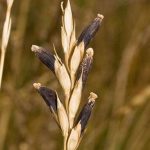 A fungus (Claviceps purpurea) that infects grasses (especially rye) and produces pharmacologically active alkaloids.
A fungus (Claviceps purpurea) that infects grasses (especially rye) and produces pharmacologically active alkaloids.
A black or dark purple parasitic fungus.
A drug obtained from a fungus that grows on rye plants.
The substance from which LSD.
A disease of rye caused by the fungus Clariceps purpurea.
A fungal disease of cereal grains and other grasses, most notoriously of rye, in which the ripe grains are replaced by masses of blackish fungal tissue. Caused by the fungus Claviceps purpurea, ergot is very poisonous and in Europe whole towns were once poisoned by eating infected bread.
Fungus (claviceps purpurea) that infects wheat, rye, and other cereal grains. It produces several alkaloids (ergonovine, ergotamine) used in medicine. Ingestion of food contaminated with ergot causes ergotism.
A fungus (Claviceps purpurea) that grows on rye. It produces several important alkaloids, chemically related to LSD, including ergotamine and ergometrine, which are used in medicine in the treatment of migraine and in childbirth. Eating bread made with rye infected with the fungus has led to sporadic outbreaks of ergotism over the centuries.
A drug obtained from Claviceps purpurea, a fungus that grows parasitically on rye. Several valuable alkaloids, such as ergotamine, are obtained from ergot.
Ergot is a product of Claviceps purpurea, a type of fungus that grows on rye and several other grains. Ergot possesses toxic alkaloids, which are substances containing nitrogen. However, some of these alkaloids have medicinal benefits when consumed in regulated doses.
The medications ergotamine, which is used for treating migraines, and ergometrine, which is utilized to manage blood loss after childbirth, miscarriage, or abortion, are both derived from ergot.
A compound obtained from Claviceps purpurea, a fungus that grows on rye, ergot or its byproducts are employed in obstetrics to induce uterine contractions and limit postpartum hemorrhage. They are also a component in medications designed to alleviate migraine symptoms. Overconsumption of ergot can lead to the narrowing of small blood vessels in the fingertips and toes, resulting in symptoms such as numbness, tingling, intense pain, and even gangrene. The phenomenon was first identified in the 15th century in Italy among rye farmers, who consumed significant amounts of their own crops, thereby ingesting large quantities of the fungus. This led to ergot poisoning, historically referred to as St. Anthony’s fire. Intriguingly, instances of St. Anthony’s fire still occur occasionally in individuals who misuse migraine medications by taking them for extended periods rather than using them briefly to counteract an acute migraine episode.
